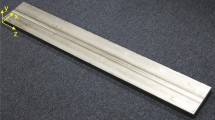Abstract
This paper describes measurements of residual stress in thin slices removed from the wall of a pressurizer safety/relief nozzle, which is a cylindrical welded component found in a nuclear power pressurized water reactor. Because the slices comprise a cross-section through a dissimilar metal weld that joins the low-alloy steel pressurizer to a stainless steel safe-end, the residual stress measurements are difficult. Typical welds have large grains and preferred orientations, along with chemical and phase gradients, that challenge diffraction techniques using neutron or x-ray beams. Welds also contain spatial gradients of residual stress that challenge mechanical release techniques like contour, slitting, and hole drilling. Therefore, the paper describes the application of, and compares the results from, three applicable residual stress measurement techniques: slitting, electronic speckle pattern interferometry hole drilling, and neutron diffraction. The results of slitting and neutron diffraction are in rough agreement, while the results from hole drilling are significantly different. An uncertainty analysis shows that slitting results had the smallest uncertainty, followed by hole drilling, and that neutron diffraction results had large uncertainty, particularly in the weld.














Similar content being viewed by others
References
EPRI (2004) “Material Reliability Program Crack Growth Rates for Evaluating Primary Water Stress Corrosion Cracking (PWSCC) of Alloy 82, 182, and 132 Welds”, MRP-115NP, Electric Power Research Institute
Dong P, Brust F (2000) Welding residual stresses and effects on fracture in pressure vessel and piping components: a millennium review and beyond. J Press Vessel Technol 122:329–338
Brown DW, Sisneros T, Holden TM (2009) “Report on residual stress measuremetns by neutron diffraction on a retired safety nozzle from the St. Lucie nuclear power station”. Intern Los Alamos Natl Lab Rep
Hill MR, Olson MD (2013) “Biaxial Residual Stress Mapping in a PWR Dissimilar Metal Weld”, PVP2013-97246, ASME 2013 Pressure Vessels & Piping Division Conference, Paris, France
Pagliaro P, Prime MB, Robinson JS, Clausen B, Swenson H, Steinzig M et al (2010) Measuring inaccessible residual stresses using multiple methods and superposition. Exp Mech 51:1123–1134
Cheng W, Finnie I, Gremaud M, Prime MB (1994) Measurement of near surface residual stresses using electric discharge wire machining. J Eng Mater Technol 116:1–7
EPRI (2011) “Materials Reliability Program: Finite-Element Model Validation for Dissimilar Metal Butt-Welds”, MRP-316, Electric Power Research Institute
Wong W, Hill MR (2013) Superposition and destructive residual stress measurements. Exp Mech 53:339–344
ISO (2005) “Non-destructive testing - Standard test method for determining residual stresses by neutron diffraction”, ISO/TS 21432, International Organization for Standardization
Bourke MAM, Dunand DC, Ustundag E (2002) SMARTS - a spectrometer for strain measurement in engineering materials. Appl Phys A Mater Sci Process 74:s1707–s1709
Larson AC, Von Dreele RB (2004) “General Structural Analysis System (GSAS)”. Los Alamos National Laboratory Report LAUR:86–748
Hutchings MT, Withers PJ, Holden TM, Lorentzen T (2005) Introduction to the characterization of residual stress by neutron diffraction. CRC Press, Boca Raton
Staron P, Koçak M, Williams S, Wescott A (2004) Residual stress in friction stir-welded Al sheets. Phys B Condens Matter 350:E491–E493
Coleman HW, Steele WG (2009) Experimentation, validation, and uncertainty analysis for engineers, Ch. 2. Wiley, Hoboken
Prime MB (1999) Residual stress measurement by successive extension of a slot: the crack compliance method. Appl Mech Rev 52:75–96
Abaqus/Standard, Version 6.10, Providence, RI, USA, 2010
Hearn EJ (1997) “Mechanics of Materials 1”, Butterworth-Heinemann
Hill MR (2013) The slitting method. In: Schajer GS (ed) Practical residual stress measurement methods. John Wiley & Sons, Ltd, Chichester, UK.
Schajer GS, Prime MB (2006) Use of inverse solutions for residual stress measurements. J Eng Mater Technol 128:375
Prime MB, Hill MR (2006) Uncertainty, model error, and order selection for series-expanded, residual-stress inverse solutions. J Eng Mater Technol 128:175–185
Steinzig M, Ponslet E (2003) “Residual Stress Measurement using the Hole Drilling Method and Laser Speckle Interferometry: Part I”. Exp Tech 43–46
Ponslet E, Steinzig M (2003) “Residual stress measurement using the hole-drilling method and laser speckle interferometry Part II: Analysis Technique”. Exp Tech:17–21
“PRISM: Residual stress measurement based on hole-drilling and ESPI”, American Stress Technologies, 2000
Schajer GS (1988) Measurement of Non-uniform residual stresses using the hole-drilling method. Part I - stress calculation proceedures. J Eng Mater Technol 110:338–343
Fredette LF, Broussard JE, Kerr M, Rathbun HJ (2011) “NRC/EPRI Welding Residual Stress Validation Program - Phase III Details and Findings”, PVP2011-57645, ASME 2011 Pressure Vessels & Piping Division Conference, Baltimore, MD, USA
Lee MJ, Hill MR (2007) Intralaboratory repeatability of residual stress determined by the slitting method. Exp Mech 47:745–752
Acknowledgments
The Electric Power Research Institute, Materials Reliability Program (Paul Crooker, Principal Technical Leader) provided financial support for this work. The PWR nozzle was part of an NRC/EPRI cooperative activity on weld residual stress, and the cooperation of the NRC is appreciated (Aladar Csontos, Matthew Kerr, David Rudland, and Howard Rathbun). During the work, the first author (Olson) was supported by the Los Alamos National Laboratory (LANL) Summer Program (Michael B. Prime, mentor). The neutron diffraction work was funded by grant #20111200 for beamtime at the SMARTS diffractometer at LANSCE. The authors also acknowledge Adrian DeWald (Hill Engineering, LLC) for a portion of the slitting measurements, and Michael B. Prime of LANL for helpful discussions.
Author information
Authors and Affiliations
Corresponding author
Rights and permissions
About this article
Cite this article
Olson, M.D., Hill, M.R., Clausen, B. et al. Residual Stress Measurements in Dissimilar Weld Metal. Exp Mech 55, 1093–1103 (2015). https://doi.org/10.1007/s11340-015-0010-8
Received:
Accepted:
Published:
Issue Date:
DOI: https://doi.org/10.1007/s11340-015-0010-8




